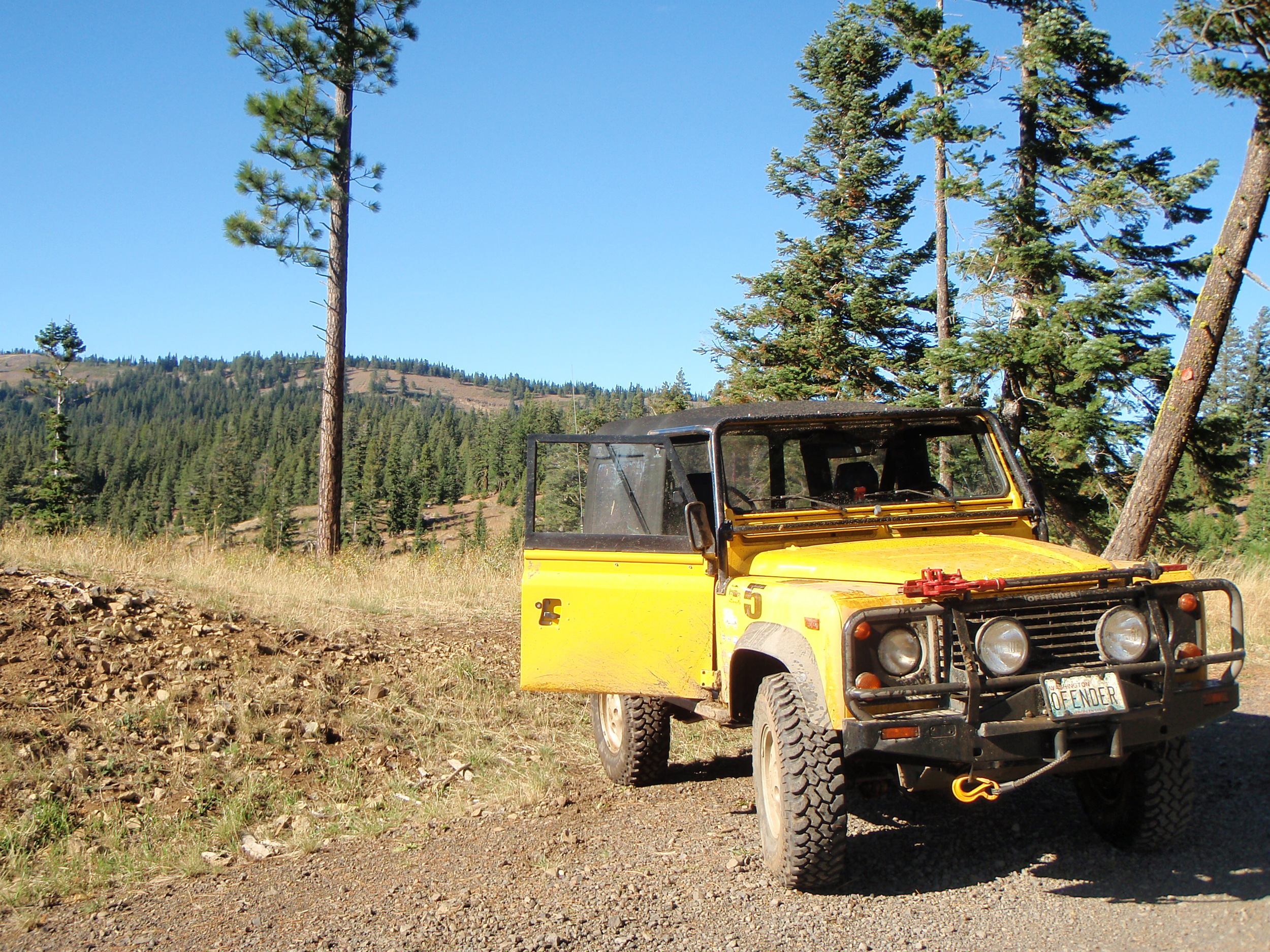Note: An article I’ve written for Rovers Magazine covering the Northwest Challenge will appear in the 2014 holiday issue. Given the space constraints for the magazine, I am posting this entry on The Atlas as a companion piece of supplemental material.
My vision is blurry from bouncing along the rocky mountain track. Every couple of minutes we catch a glimpse of the muddy orange Range Rover Classic when the trail runs straight for a stretch. Occasionally brake lights flicker ahead of us through the dust. Gord’n is driving like a madman. It’s like the Dukes of Hazzard in four-wheel-drive at 4,000 feet in the Cascades, only instead of pursuing the brazen Duke boys with a bumbling sheriff I’m grasping the door as my friend Lar pushes his Land Rover Defender 90 to keep up. I can’t see the speedometer, but if I could I know the needle would be far outside the “sensible” zone.
When driving off-road I try to abide by the adage “as slow as possible, as fast as necessary.” The inverse of this pushes my comfort levels in ways I hadn’t expected. Were it not for the heat of competition we wouldn’t be driving this fast, but we’re on a mission.
A smooth road: don't look at the speedo.
Lar zooms past basalt cliffs above the Little Naches River
It’s 6:42pm on the last Saturday in September, the sun is setting, and we’re in the thick of the 25th anniversary running of the Northwest Challenge. We have a cutoff time to be back in camp by 7:00 and at this pace I wonder if we just might make it. Taking the turn off Highway 410 onto the spur leading into the campsite Gord’n squeals his chunky mud tires as they throw off a cloud of acrid, blue smoke. I hold my breath as two of his wheels lift off the ground. With great relief we come to a stop in camp. It’s 7:08 and standing still feels strange.
The Northwest Challenge is an annual, multidisciplinary contest held by Land Rover enthusiasts for Land Rover enthusiasts. It draws competitors and their vehicles from Oregon, Washington, and British Columbia- sometimes points even further afield. This year the Pacific Coast Rovers Club hosted the event over three days in the rugged terrain southeast of Mount Rainier.
Mount Rainier keeps an eye on proceedings
Up high on the ridges the terrain was rocky and dry.
Down in the forested valleys we had a harder time with traction. Lar winches up Aardvark Hill.
As rookies, Lar and I didn’t have a clear sense of what to expect. Details around the event were sparse and we gathered that part of the challenge of the Challenge is that you have to figure things out as you go along. We knew it would involve special tasks testing a range of skills, from driving technique to navigation, mechanical aptitude to problem solving. We didn’t anticipate rally cross driving in vehicles that were not designed for speed, but that wasn’t part of the event’s intent. That was a consequence of drawing Gord’n and his navigator, Cary, to pair up with as a group.
A rare moment at rest: Lar, Cary, Nick, and Gord'n take a quick break during transition between tasks at the 2014 Northwest Challenge.
Gord’n runs Lamorna Garage in Seattle, a quirky yet bustling repair business specializing in Land Rovers. If you know the marque, their reputation for (un)reliability may be deserved and consequently his schedule is packed. On any given day you may pass through his quiet corner of Ballard and see trucks spanning fifty years of production on Rover Row near his shop. It is not uncommon to see a 2007 L322 Range Rover alongside a 1965 Series IIa, both awaiting attention. Gord’n knows these machines like few others do, and this intimate familiarity extends to his knowing the limits of the possible in their performance, knowing where those limits are hard and where they are flexible.
"We have ten minutes until our next task starts? Great, I'll change my alternator belt." The mechanic in action.
Yet Lar is no slouch. Having completed a ground-up rebuild of his 1997 Defender single handedly, he knows a thing or two about it. Plus his yellow brick of a truck has a secret weapon: the 4.6-liter V8 engine transplanted from a P38 Range Rover. This upgrade transforms a ponderous Clydesdale into a fleet Arabian racehorse…more or less. Yet speed is useless without control. I relax - a bit - when we zoom alarmingly close to trees because Lar’s other car is a Porsche that he bought from Sir Mix-a-Lot.
Softer tires = more traction = more speed. Lar airs down without feeling deflated.
Friday night was a mad scramble. In the Cascade mist the event organizer, Mike Bach, handed out lists of lat-long coordinates to each team. Our main task for the night was to link these up and find painted markers in the forest hidden near each coordinate. Cary, who was practically buried in devices, cables, and plugs festooning the cabin of Gord’n’s Rover, entered the waypoints into his iPad’s navigational software (not Apple Maps, you can be sure). We ended up driving the length of the Naches Trail, a historical route that Lar and I have traveled several times. Only this night we completed it in less than half the time it usually takes us in daylight, including the time spent hunting around in the forest looking for painted markers on dead logs.
Saturday’s 12-hour (and 8 minute) dash took us through some wonderful stretches of trail I’d never before traveled. Some I may never travel again. Frequently throughout the day I thought to myself how glad I was to be in Lar’s Defender. My own Discovery, reasonably close to stock, would not have sustained such abuse. Other competitors’ vehicles took a beating, as well. Around the campfire on Saturday night we heard tales of sheared shock absorbers, snapped drive shafts, dented panels, expired starters, the list of casualties went on.
A capable Rover, but in need of a few modifications before entering the Northwest Challenge.
At the end of it all I was exhausted. For being a vehicle-based competition, there was a surprising amount of physical activity involved. I spent a lot of time running, performing an ungainly parcours through the woods as I searched for markers, hauled winch lines up hills, sprinted ahead of Lar to spot him on a trials course, or dashed to a prime vantage point to take a photograph before the moment passed. As a teenager I was in awe of the feats of the competitors on the Camel Trophy events in the planet’s most remote regions. The Northwest Challenge came nowhere close to that level of intensity, but for one weekend I could work hard with a worthy companion as we explored new terrain, collaborated under pressure, and fraternized with our fellow enthusiasts. What is it about Land Rovers that inspires such irrational, bloody-minded devotion?
Lar and I did not win the Northwest Challenge. Ultimately it was Gord’n and Cary who took top honors, and from my point of view it was well deserved. Their collective daring and skill earned them a comfortable margin of victory. Lar and I need some time to recover from the 2014 event before we start thinking about next year’s contest. I need to do some work on my own Rover, too. Plus ça change.
This is what we imagined we were doing. Photo by Lou Sapienza.










